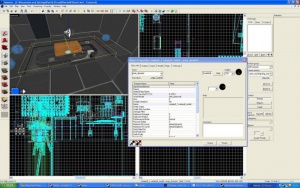Faith Plate
Faith plates or catapults are jump pads in ![]() Portal 2. They can fling objects like turrets, cubes, and players.
Portal 2. They can fling objects like turrets, cubes, and players.
Creation
There are several instances; however, the trigger_catapult will need to be added manually. Set its output to trigger the instance, which includes both the sound and the animation.
- gameplay\faithplate_black.vmf
- gameplay\faithplate_black_impostor.vmf
- gameplay\faithplate_clean.vmf
- gameplay\faithplate_dirty.vmf
- gameplay\faithplate_dirty_impostor.vmf
1) Make a prop_dynamic:
Property Name Value World Model "models/props/faith_plate.mdl" or "models/props/faith_plate_128.mdl" Name "catapult_model_1" (you can change it, but dont forget to change it in all inputs.) Collision Not Solid Disable Shadows Yes
2) Make an info_target
Property Name Value Name catapult_target_1
- The catapult will launch you onto that target.
3) Make a trigger_catapult with trigger texture:
Property Name Value Name catapult_trigger_1 Launch Direction "-90 0 0" If you want to fly up Player speed Try random for your length of pit, 750 is better Physics speed This for flinging props. I have +150 to Player speed (900). Apply Angular impulse True Launch target catapult_target_1 Use Threshold Check Set to NO for Faith Plate model.
4) Make an ambient_generic:
Property Name Value Name catapult_sound_1 Sound Name World.CatapultLaunch SourceEntityName catapult_model_1 (the name of the Faith Plate model)
Flags Value Is NOT Looped Yes Start Silent Yes
To make the sound work, you must go back to your trigger_catapult and create a new output: Oncatapulted, sound entity name, playsound.
5) Make a block with the tools/toolsinvisible texture in space under faith plate model, so that the player and objects don't fall through.
6) Also, don't forget to add an info_placement_helper to the portalable surface at the end of your trajectory—it's easier to fly through.
Debugging
As heard in the developer commentary, Valve used visual trajectories to help debug and tweak the faith plates.
In the developer console, type ent_bbox trigger_catapult. You will now see a visual representation of the trajectories of every trigger_catapult in the map. If you want to just see a single trajectory, type ent_bbox <name of your catapult entity>, but you must type "developer 1" first.
If your trigger_catapult is using exact velocity you can change player and physics velocity in game.
- "ent_fire <name of catapult entity> setplayerspeed <speed>"
- "ent_fire <name of catapult entity> setphysicspeed <speed>"
The visual trajectories will update automatically.
Tips
You can also use the trigger_catapult anywhere you expect the player to land for greater control. For example, you may place a portal on a wall angled upwards and fling out of that.
To make sure the catapult doesn't fling you when you just walk into it, set the thresholds. In the trigger_catapult settings:
Property Name Value Lower threshold This is a percentage, 0 to 1, of the player speed you set. Upper threshold Same as above but for the upper limit. UseThresholdCheck 'YES' to use threshold, 'NO' to always catapult.
However, the threshold settings are a little difficult to handle:
First off, contrary to common understanding, the thresholds do not represent percentages of the player speed in a conventional understanding. Lower threshold is a percentage value that is deducted from the player speed as set in the trigger_catapult settings while the upper threshold percentage is added to the player speed. For example, say you set the catapult to fling the player at 500 units/second. A lower threshold of 0.1 means the player must travel at least at 90%, i.e., 100% minus 10%, of that: 450 units/second. An upper threshold of 0.5 means the player must not travel faster than 150%, i.e., 100% plus 50%, of that: 750 units/second. As long as the player speed is between these limits the trigger_catapult will catapult the player/object. In consequence, the thresholds only work one way: the lower the thresholds are set, the more the player speed has to match the catapulting speed.
Unfortunately, there's more to consider: if there is a target specified for the trigger_catapult, the player speed will be adjusted to reach that target, thus making it impossible to know the exact speed the player will have to be catapulted at. Even if Use Exact Velocity is set to yes, there will probably be variances to the player speed. Therefore, catapulting thresholds should cover a somewhat bigger spectrum of possible speeds.
Yet all this can be more or less easily tested: for debugging purposes, programmers added the ent_bbox console command for a graphic display of catapult trajectories in-game. Fortunately, this command will also state current player speed and actual thresholds (in units/second) when the player/an object enters the trigger_catapult. Please note that a trigger_catapult must have a target specified in order for this to work.
